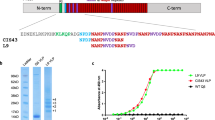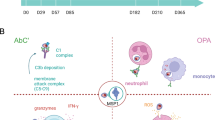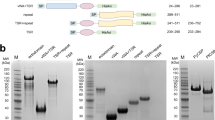Abstract
PROTECTIVE immunity against malaria is induced by vaccination of hosts with irradiation-attenuated sporozoites. This immunity is mediated in part by neutralizing antibodies that are directed mainly against the repeat domain of the circumsporozoite protein1–4. Early experiments showed, however, that B-cell-depleted mice that are immunized with sporozoites can resist challenge, indicating that T-cell effector mechanisms may also have a role in protection5. This idea was supported by the recent observation that protective immunity also requires T-cells expressing the CDS antigen (CD8+ T cells) 6,7, whose target is probably the developing liver-stage parasites8–10. Moreover, an oral Salmonella vaccine that expresses the circumsporozoite protein is able to protect against murine malaria in the absence of antibodies11. Here we report the identification of an epitope contained within amino acids 249–260 of the Plasmodium berghei circumsporozoite protein that is recognized by H–2Kd-restricted cytotoxic T cells12,13. Passive transfer into mice of cytotoxic-T-cell clones that recognize this epitope conferred a high degree of protection against challenge. These results provide the first direct evidence that CD8+ T cells that are specific for a defined epitope can confer protection against a parasitic infection.
This is a preview of subscription content, access via your institution
Access options
Subscribe to this journal
Receive 51 print issues and online access
$199.00 per year
only $3.90 per issue
Buy this article
- Purchase on Springer Link
- Instant access to full article PDF
Prices may be subject to local taxes which are calculated during checkout
Similar content being viewed by others
References
Nussenzweig, V. & Nussenzweig, R. S. Adv. Immun. 45, 283–322 (1989).
Potocnjak, P. et al. J. exp. Med. 151, 1504–1513 (1980).
Hollingdale, M. R., Zavala, F., Nussenzweig, R. S. & Nussenzweig, V. J. Immun. 128, 1929–1930 (1982).
Charoenvit, Y., Leef, M. F., Yuan, L. F., Sedegah, M. & Beaudoin, R. L. Infect. Immunity 55, 604–608 (1987).
Chen, D. H., Tigelaar, R. E., & Weinbaum, F. I. J. Immun. 118, 1322–1327 (1977).
Schofield, L. et al. Nature 330, 664–666 (1987).
Weiss, W. R. et al. Proc. natn. Acad. Sci. U.S.A. 85, 573–576 (1988).
Ferreira, A. et al. Science 232, 881–884 (1986).
Maheshwari, R. K. et al. Infect. Immunity 53, 628–629 (1986).
Hoffman, S. L. et al. Science 244, 1078–1081 (1989).
Sadoff, J. C. et al. Science 240, 336–338 (1988).
Eichinger, D. J., Arnot, D. E., Tam, J. P., Nussenzweig, V. & Enea, V. Molec. cell. Biol. 6, 3965–3972 (1986).
Weber, J. L. et al. Expl. Parasit. 63, 295–300 (1987).
Townsend, A. R. M. & Bodmer, H. A. Rev. Immun. 7, 601–624 (1989).
Lal, A. A. et al. J. biol. Chem. 262, 2937–2940 (1987).
Braciale, T. J., Sweetser, M. T., Morrison, L. A., Kittlesen, D. J. & Braciale, V. L. Proc. natn. Acad. Sci. U.S.A. 86, 277–281 (1989).
Maryanski, J. L., Pala, P., Corradin, G. P., Jordan, B. R. & Cerottini, J. C. Nature 324, 578–579 (1986).
Oldstone, M. B. A., Whitton, J. L., Lewicki, H. & Tishon, A. J. exp. Med. 168, 559–570 (1988).
Takahashi, H. et al. Proc. natn. Acad. Sci. U.S.A. 85, 3105–3109 (1988).
Bodmer, H. C., Pemberton, R. M., Rothbard, J. B. & Askonas, B. A. Cell 52, 253–258 (1988).
Kumar, S. et al. Nature 334, 258–260 (1988).
Maryanski, J. L., Accolla, R. S. & Jordan, B. J. Immun. 136, 4340–4347 (1986).
Taylor, P. M. & Askonas, B. A. Eur. J. Immun. 13, 707–711 (1983).
Dailay, M. O., Fathman, G., Butcher, E. C., Pillemer, E. & Weissman, I. J. Immun. 128, 2134–2136 (1982).
Carbone, F., Moore, M., Sheil, J. & Bevan, M. J. exp. Med. 167, 1767–1779 (1988).
Townsend, A. et al. J. exp. Med. 168, 1211–1224 (1988).
Taylor, P. M. & Askonas, B. A. Immunology 58, 417–420 (1986).
de la Cruz, V., Lal, A. A. & McCutchan, T. F. Molec. biochem. Parasit. 28, 31–38 (1988).
Romero, P. J. et al. Eur. J. Immun. 18, 1951–1957 (1988).
Schreiber, R. D., Hicks, L. J., Celada, A., Buchmeier, N. A. & Gray, P. W. J. Immun. 134, 1609–1613 (1985).
Author information
Authors and Affiliations
Rights and permissions
About this article
Cite this article
Romero, P., Maryanski, J., Corradin, G. et al. Cloned cytotoxic T cells recognize an epitope in the circumsporozoite protein and protect against malaria. Nature 341, 323–326 (1989). https://doi.org/10.1038/341323a0
Received:
Accepted:
Issue Date:
DOI: https://doi.org/10.1038/341323a0
This article is cited by
-
STING-pathway modulation to enhance the immunogenicity of adenoviral-vectored vaccines
Scientific Reports (2022)
-
Ultra-low dose immunization and multi-component vaccination strategies enhance protection against malaria in mice
Scientific Reports (2021)
-
T cell-mediated immunity to malaria
Nature Reviews Immunology (2019)
-
Recombinant measles vaccine expressing malaria antigens induces long-term memory and protection in mice
npj Vaccines (2019)
-
Malaria prevention: from immunological concepts to effective vaccines and protective antibodies
Nature Immunology (2018)
Comments
By submitting a comment you agree to abide by our Terms and Community Guidelines. If you find something abusive or that does not comply with our terms or guidelines please flag it as inappropriate.



